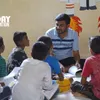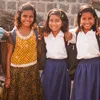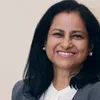Founded in 1999 in Bengaluru, Agastya’s vision for education is aptly captured in the mantra Ah, Aha, Ha-ha (awakening, understanding, delight). Its founder, Ramji Raghavan left a corporate banking career in New York to transform education for children at scale in India.
Agastya runs nation-wide education innovation initiatives from a sprawling campus in Kuppam, Andhra Pradesh, as well as mobile education vans and motorbikes for outreach. It supplies resources and training to government schools, with a focus on science education, arts, and design thinking. See YourStory’s photo essays on Agastya’s Ramanujan Math Park, Innovation Studio and Arts Centre.
In this interview, Ramji describes the challenges the education sector is facing due to the pandemic, the importance of blended learning, and how Agastya is scaling up for an educational movement in India.
Edited excerpts of the interview:
YourStory [YS]: What are the challenges the education sector is facing due to the pandemic?
Ramji Raghavan [RR]: Physical activity in most schools has come to a standstill. It’s a terrible blow to millions of children and schoolteachers, not to mention parents. Research suggests that if a Grade III child misses even three or four months of school, it creates a compounded learning deficit that could last until Grade X. That’s huge.
There will be therapeutics and a vaccine for COVID-19. But the effects of a psychological scar or setback for a child from missing school for an extended period can be permanent. Large numbers of underprivileged children could drop out of the education system, undoing all the good work done by government, NGOs, social investors and others over the last several years.
Then there’s the whole impact on teachers, their confidence and motivation. Which means, we must take strong and immediate actions to offset as many of the negative social fallouts of COVID-19 as possible.
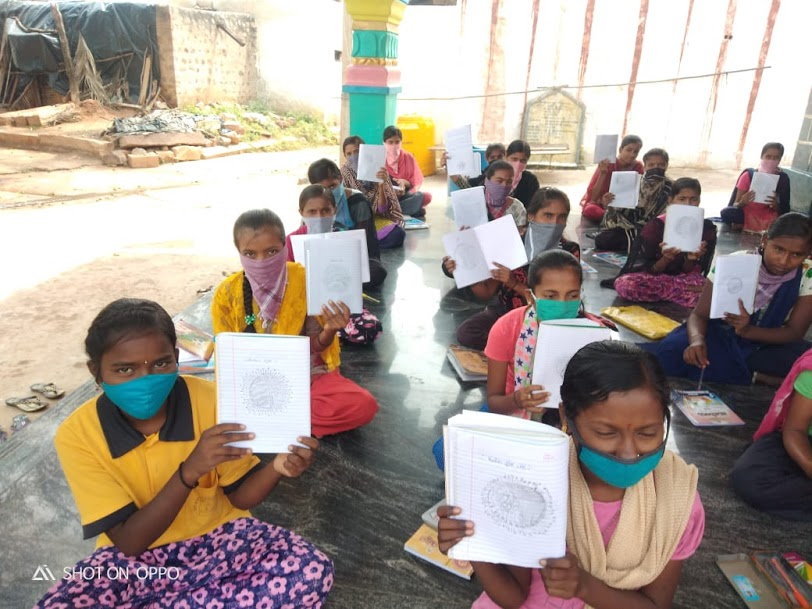
Classes by Agastya during the pandemic (picture courtesy Agastya International Foundation)
YS: How is the Agastya International Foundation coping with the COVID-19 crisis?
RR: Like almost everyone, we got knocked down to our knees, but have risen to fight the battle! Agastya has pivoted big time to digital-online education, with a difference. The difference lies in making sure that our digital-online content and pedagogy are integrated with our core hands-on pedagogy.
We do this by ensuring our digital-online classes have a strong visual science-experiment component, and keeping them simple and replicable at home. Children and schoolteachers are given hands-on assignments, which they can perform at home with everyday materials like plastic bottles, balloons, food items, basic chemicals and the like (“the home becomes the lab”).
Students have an opportunity to showcase their work, get constructive feedback and resolve their doubts and questions. We distribute low cost educational kits to sustain the learning process. We also work with the state education departments to promote online teacher training.
We have also started an initiative to teach design thinking to mothers in villages. These initiatives have helped to energize and lift Agastya’s spirit.
Agastya received a further boost when we learnt that a study by the Museum of Mathematics, New York and Imaginary, Germany ranked Agastya’s Ramanujam Math Park as among the top 15 math museums in the world!
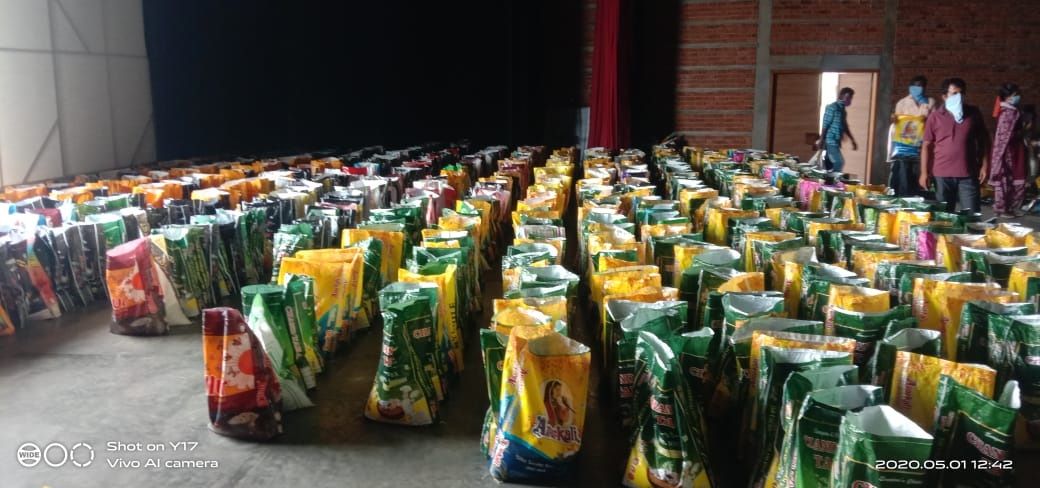
Food packets distributed by Agastya during the pandemic (picture courtesy Agastya International Foundation)
YS: How has Agastya engaged with its constituencies to cope with COVID-19?
RR: Early on, we offered our mobile science vans to transport PPE. For example, we supported the DEBL (Defence Bioengineering and Electromedical Laboratory) to transport PPE from Coimbatore to Bengaluru.
We also distributed food to thousands of needy families near our Gudivanka campus. We raised money from individuals to distribute food packets and COVID-19 kits to needy families and migrant workers in several states.
We have launched multidisciplinary, local language COVID-19 education modules to help children, teachers and parents understand and deal with COVID-19.
YS: In what ways has the pandemic impacted your mission of sparking curiosity, creativity and confidence in children?
RR: Every crisis, especially an unprecedented one like COVID-19, gives birth to a great opportunity. The great opportunity for Agastya is to emerge as an organisation that offers blended learning – hands-on physical combined with digital-online – at scale. Achieving that would be unique by most global standards.
Last year, Agastya reached two million children – one million face-to-face, and another million indirectly through the teachers we trained. We had decided about three years ago that we would transform Agastya, the NGO, to Agastya the NGM, or transform it from a scaled organisation to a movement.
It requires us to be fluid, flexible and adaptable and reach out to many more constituencies of influencers and decision makers. My sense is that the COVID-19 crisis will accelerate our “movement towards a movement” and spread the spirit of Aah! Aha! Ha-Ha! to much larger numbers of people across the country.
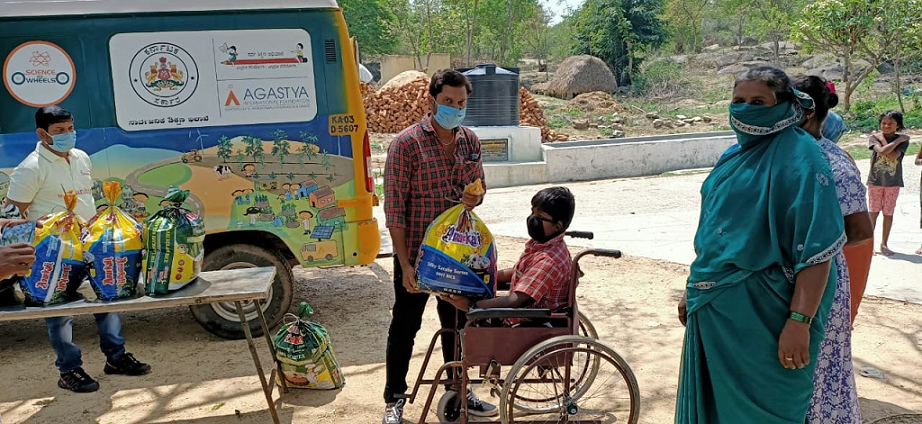
Pandemic relief work by Agastya (picture courtesy Agastya International Foundation)
YS: How does online education compare to the richness and quality of hands-on physical learning experiences?
RR: Risks are inevitable in any strategy. A major risk is that in the herd rush to online learning, schools might drop hands-on physical learning altogether. That would be a gigantic mistake in a country that is weak in hands-on learning, and has paid a dear price for it in terms of foregone innovation and creativity.
The question is not which type of learning is better – physical or online. The question is, how might we combine, or blend both to reach a much higher level of experiential learning?
For example, leveraging the reach of online learning and its capacity to create What if? types of learning moments can enrich, expand and amplify physical hands-on learning, and vice-versa.
Can Agastya expand its current reach of two million children every year by 5X or 50X without reducing quality? I believe that Agastya’s blended strategy will take it to a significantly higher level of scale and quality.
YS: What are some ways of overcoming the looming digital divide in under-privileged communities?
RR: This is a troubling and challenging question. There is no silver bullet yet, other than perhaps making internet access free! Turing Award winner Raj Reddy of Carnegie Mellon University proposed this idea at a talk at the Indian Institute of Science several years ago. Perhaps the time has come to challenge us to achieve Reddy’s dream.
Agastya meanwhile is pushing ahead. For example, we have recruited hundreds of college students in North Karnataka, who have gone back to their villages and use their cell phones to teach the poorest children in their villages. We broadcast science experiment demo classes on TV to help students prepare for their board exams.
We have trained thousands of schoolteachers across the country to learn online themselves, and teach students online. Agastya has also launched smart TVs in villages to support online and offline education.
Besides restarting our mobile lab school visits in a few states, we are executing a novel strategy in several hundred villages in Gujarat, Karnataka, AP and Maharashtra, Chattisgarh, Jharkhand, Odisha, West Bengal, Assam, Sikkim, and Meghalaya. We are taking our mobile science vans and motorbikes to the villages to run in-person science classes while ensuring that all health and safety protocols are met (see our YouTube video of the COVID-19 Lab-on-a-Tab and Lab-on-a-Bike programs).
If children can’t come to school, let’s take the physical school to them! This is a strategy that the nation as a whole might consider implementing both during and post COVID-19. We are also experimenting with smart TVs to deliver digital content in villages. To reach scale, we need more funding for such innovations.
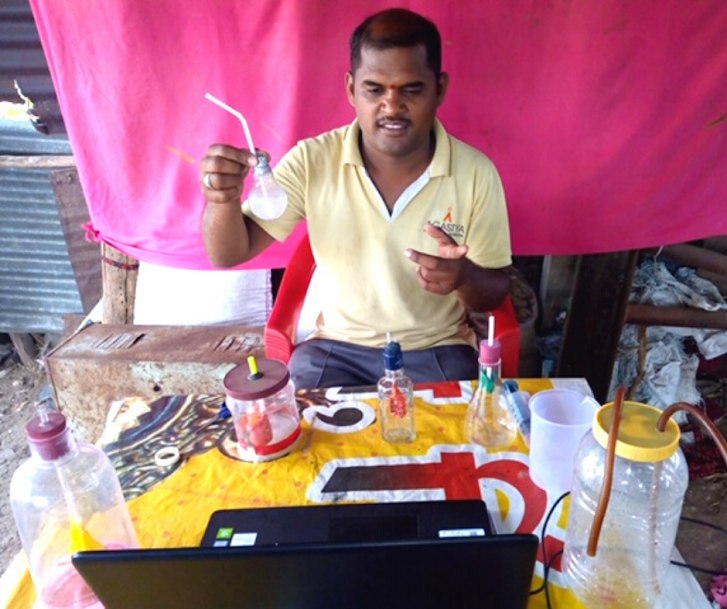
Online science lab by Agastya (picture courtesy Agastya International Foundation)
YS: What are some examples of creativity and resilience you have seen among your teams and staff amidst this crisis?
RR: It’s amazing how people respond creatively in a crisis. I am sure there are brilliant examples of this among NGOs and enterprises of all hues. Agastya teachers have been beaming science classes from their homes and, where possible, from Agastya science centers.
Agastya teachers Pandurang and Balaji did not have space in their homes to run online classes, so they converted a cowshed on a farm into a science center and are beaming online classes! Revathy Narayanan and Mohammed Peershavali of Agastya have developed 'Explore, Play and Learn' modules in science for village kids.
Our Telangana team led by Agastya’s first employee Balaram created a digital science fair, a wonderful innovation that has triggered us to create digital versions of all our science and innovation fair offerings. We have launched Innovation Express 1.0, a digital platform for thousands of people to bring forward and communicate their innovations.
Ganu Subramanian of Agastya, an ex-IIT and IIM graduate, formerly with Reliance, is doing pioneering work with professors from IISER Tirupati in identifying and mentoring highly talented children online. He is developing digital simulation games centered on COVID-19.
Ravi Kailas of the Pravaha Foundation has come forward to support this project. We are working with JP Morgan on a Schools Challenge programme in Mumbai that teaches children how to innovate, lead and problem-solve. Most importantly, many governments like Karnataka, Maharashtra, Haryana, Madhya Pradesh and AP have been very supportive. As someone said, “never waste a crisis.”
YS: How are your donors and supporters responding in this crisis?
RR: This is a time of belt tightening for everyone and NGOs are feeling the brunt of it. Saying that it is NOT business as usual would be a great understatement.
Having said that, our partners have shown great consideration and empathy towards Agastya’s cause. They include Honeywell, L&T Public Charitable Trust, Cipla Foundation, Infosys, HT Parekh Foundation, Adobe, JP Morgan, Broadcom, Synopsys, EdelGive, Cognizant, and others.
Agastya board member Rakesh Jhunjhunwala has been a steadfast supporter through thick and thin for nearly two decades. People like AM Naik of L&T have donated personally to charity in a big way; he spends a third of his time on charity.
Kiran Mazumdar Shaw of Biocon has come forward to fund an exciting COVID-19 related education project with Agastya. Google board member Ram Shriram’s Dhanam Foundation has made a major commitment to help educate India’s kids.
These are just a few inspiring examples. The crisis induced by COVID-19 should motivate society to raise, not reduce, its commitment to those less fortunate.
To use a business analogy, Tom Watson of IBM took eye-popping risks in going against the current and expanding IBM massively when everyone else was contracting in the face of two unprecedented crises – the Great Depression and the Second World War. His against-the-odds bets set IBM up for success for the next fifty years.
We too need to commit to a healthy dose of counter-intuition by increasing, not decreasing, support for NGOs. There’s no better time than now to bet on the future.
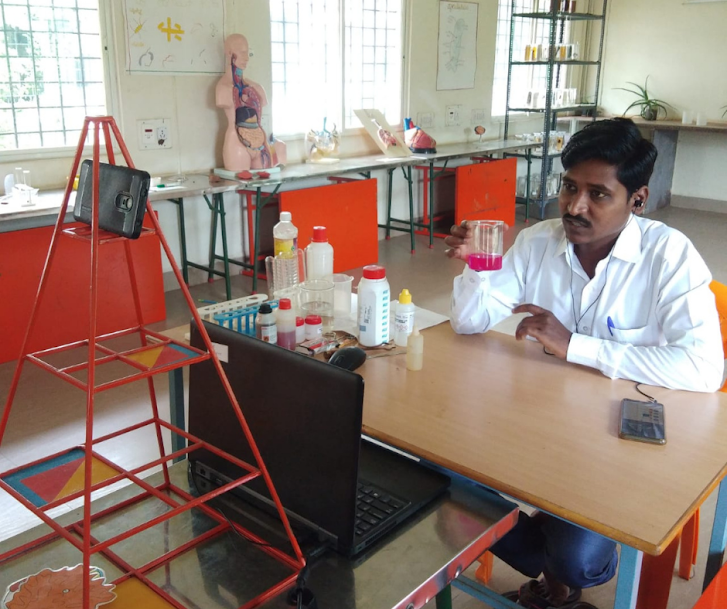
Online learning by Agastya (picture courtesy Agastya International Foundation)
YS: What are some of Agastya’s other specific plans for the future?
RR: Our future plans are being driven by a heightened focus on R&D. Partly because people are less distracted with moment-to-moment responsibilities, they have more time to think and create. We continue to build an innovative new curriculum integrating science, art and design thinking.
We would like to create a virtual experience of our 172-acre creativity campus. With our partner, Pravaha Foundation, we would like to build more campuses around themes like innovation and sustainability across India.
A student once complained to Nobel laureate CV Raman that a scientist in the UK working on the same problem had a five-kilowatt X-ray tube while he only had a one-kilowatt X-ray tube at his disposal. “There is a very simple solution. Put a ten-kilowatt brain on the problem,” Raman said.
COVID-19 is indeed terrible, but it has created a great opportunity for Agastya – and India - to apply large numbers of ten-kilowatt brains to solve new problems.
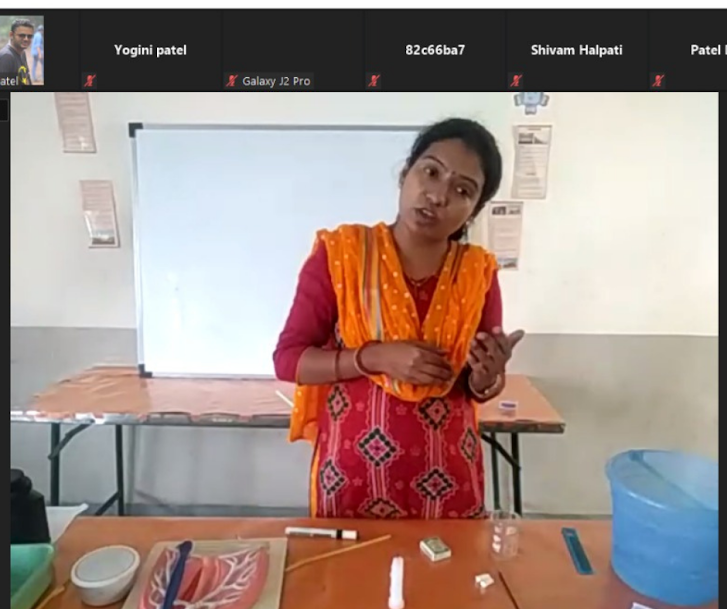
Online education by Agastya teacher (picture courtesy Agastya International Foundation)
YS: How do you see the new National Education Policy 2020 impacting education in general, and Agastya in particular?
RR: NEP 2020 represents a fundamental shift in education policy from exam-driven, content-heavy, rote-based learning to creative hands-on experiential learning. As PM Narendra Modi said, NEP 2020 represents a shift from “what to think” to “how to think.”
Agastya is thrilled to see the much-needed shift in education policy. For two decades, Agastya has pioneered and advocated hands-on experiential learning based on curiosity, imagination and creativity. Now the great opportunity is at hand for Indians to remake the country into a leader in creativity and innovation.
NEP 2020’s success will rest on excellent execution by the state governments. Agastya is ready and willing to support all stakeholders in making the intent and content of NEP 2020 happen. When it does, it will transform India’s destiny!
Edited by Anju Narayanan
Link : https://yourstory.com/2020/11/agastya-ramji-raghavan-blended-learning-pandemic
Author :- Madanmohan Rao ( )
November 09, 2020 at 01:06PM
YourStory

